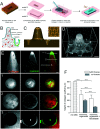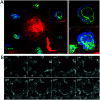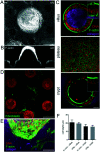Developing an advanced gut on chip model enabling the study of epithelial cell/fibroblast interactions
- PMID: 33306083
- PMCID: PMC9930731
- DOI: 10.1039/d0lc00672f
Developing an advanced gut on chip model enabling the study of epithelial cell/fibroblast interactions
Erratum in
-
Correction: Developing an advanced gut on chip model enabling the study of epithelial cell/fibroblast interactions.Lab Chip. 2023 Mar 14;23(6):1713. doi: 10.1039/d3lc90020g. Lab Chip. 2023. PMID: 36852524 Free PMC article.
Abstract
Organoids are widely used as a model system to study gut pathophysiology; however, they fail to fully reproduce the complex, multi-component structure of the intestinal wall. We present here a new gut on chip model that allows the co-culture of primary epithelial and stromal cells. The device has the topography and dimensions of the mouse gut and is based on a 3D collagen I scaffold. The scaffold is coated with a thin layer of laminin to mimic the basement membrane. To maintain the scaffold structure while preserving its cytocompatibility, the collagen scaffold was rigidified by threose-based post-polymerization treatment. This treatment being cytocompatible enabled the incorporation of primary intestinal fibroblasts inside the scaffold, reproducing the gut stromal compartment. We observed that mouse organoids, when deposited into crypts, opened up and epithelialized the scaffold, generating a polarized epithelial monolayer. Proper segregation of dividing and differentiated cells along the crypt-villus axis was achieved under these conditions. Finally, we show that the application of fluid shear stress allows the long-term culture of this intestinal epithelium. Our device represents a new biomimetic tool that captures key features of the gut complexity and could be used to study gut pathophysiology.
Conflict of interest statement
There are no conflicts to declare.
Figures





Similar articles
-
3D in vitro morphogenesis of human intestinal epithelium in a gut-on-a-chip or a hybrid chip with a cell culture insert.Nat Protoc. 2022 Mar;17(3):910-939. doi: 10.1038/s41596-021-00674-3. Epub 2022 Feb 2. Nat Protoc. 2022. PMID: 35110737 Free PMC article. Review.
-
A microengineered collagen scaffold for generating a polarized crypt-villus architecture of human small intestinal epithelium.Biomaterials. 2017 Jun;128:44-55. doi: 10.1016/j.biomaterials.2017.03.005. Epub 2017 Mar 6. Biomaterials. 2017. PMID: 28288348 Free PMC article.
-
Micro-patterned endogenous stroma equivalent induces polarized crypt-villus architecture of human small intestinal epithelium.Acta Biomater. 2018 Nov;81:43-59. doi: 10.1016/j.actbio.2018.09.061. Epub 2018 Sep 30. Acta Biomater. 2018. PMID: 30282052
-
Synergic effects of crypt-like topography and ECM proteins on intestinal cell behavior in collagen based membranes.Biomaterials. 2010 Oct;31(29):7586-98. doi: 10.1016/j.biomaterials.2010.06.036. Biomaterials. 2010. PMID: 20643478
-
Intestinal organoids in farm animals.Vet Res. 2021 Feb 25;52(1):33. doi: 10.1186/s13567-021-00909-x. Vet Res. 2021. PMID: 33632315 Free PMC article. Review.
Cited by
-
3D in vitro morphogenesis of human intestinal epithelium in a gut-on-a-chip or a hybrid chip with a cell culture insert.Nat Protoc. 2022 Mar;17(3):910-939. doi: 10.1038/s41596-021-00674-3. Epub 2022 Feb 2. Nat Protoc. 2022. PMID: 35110737 Free PMC article. Review.
-
Biofabricated 3D Intestinal Models as an Alternative to Animal-Based Approaches for Drug Toxicity Assays.Tissue Eng Regen Med. 2025 Feb;22(2):181-194. doi: 10.1007/s13770-024-00694-6. Epub 2025 Jan 17. Tissue Eng Regen Med. 2025. PMID: 39820960
-
Advances in human organs-on-chips and applications for drug screening and personalized medicine.Fundam Res. 2024 Feb 22;5(3):1258-1272. doi: 10.1016/j.fmre.2023.12.019. eCollection 2025 May. Fundam Res. 2024. PMID: 40528968 Free PMC article. Review.
-
Applications of human organoids in the personalized treatment for digestive diseases.Signal Transduct Target Ther. 2022 Sep 27;7(1):336. doi: 10.1038/s41392-022-01194-6. Signal Transduct Target Ther. 2022. PMID: 36167824 Free PMC article. Review.
-
Cellular shape reinforces niche to stem cell signaling in the small intestine.Sci Adv. 2022 Oct 14;8(41):eabm1847. doi: 10.1126/sciadv.abm1847. Epub 2022 Oct 14. Sci Adv. 2022. PMID: 36240269 Free PMC article.
References
Publication types
MeSH terms
LinkOut - more resources
Full Text Sources
Other Literature Sources

